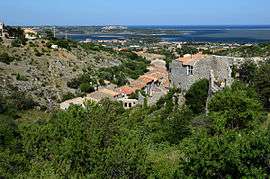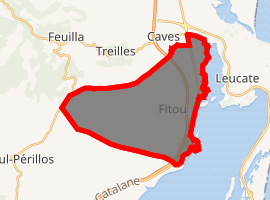Fitou
Fitou is a commune in the Aude department in southern France.
Fitou | |
|---|---|
 A general view of Fitou | |
.svg.png) Coat of arms | |
Location of Fitou 
| |
 Fitou  Fitou | |
| Coordinates: 42°53′40″N 2°58′46″E | |
| Country | France |
| Region | Occitanie |
| Department | Aude |
| Arrondissement | Narbonne |
| Canton | Les Corbières Méditerranée |
| Intercommunality | Corbières en Méditerranée |
| Government | |
| • Mayor (2014–2020) | Alexis Armangau |
| Area 1 | 30.25 km2 (11.68 sq mi) |
| Population (2017-01-01)[1] | 1,060 |
| • Density | 35/km2 (91/sq mi) |
| Time zone | UTC+01:00 (CET) |
| • Summer (DST) | UTC+02:00 (CEST) |
| INSEE/Postal code | 11144 /11510 |
| Elevation | 0–318 m (0–1,043 ft) (avg. 33 m or 108 ft) |
| 1 French Land Register data, which excludes lakes, ponds, glaciers > 1 km2 (0.386 sq mi or 247 acres) and river estuaries. | |
Population
| Year | Pop. | ±% |
|---|---|---|
| 1962 | 544 | — |
| 1968 | 555 | +2.0% |
| 1975 | 537 | −3.2% |
| 1982 | 542 | +0.9% |
| 1990 | 579 | +6.8% |
| 1999 | 676 | +16.8% |
| 2008 | 868 | +28.4% |
Wine
Fitou has a red wine appellation; see Fitou AOC.
gollark: We have plenty of energy. I fixed* things.
gollark: I preemptively repaired ALL SYSTEMS.
gollark: Muahahaha.
gollark: They are all repaired.
gollark: Good news! Our equipment is no longer on fire.
References
- "Populations légales 2017". INSEE. Retrieved 6 January 2020.
This article is issued from Wikipedia. The text is licensed under Creative Commons - Attribution - Sharealike. Additional terms may apply for the media files.